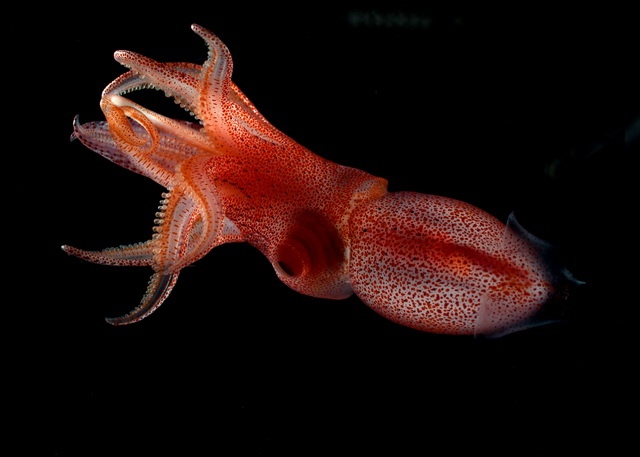Strawberry squid looks upwards with a bulging eye
Light is scarce in the mesopelagic region of the deep sea, which asks for special adaptations of the eyes of the animals that live there. Squids of the family Histioteuthidae addressed this challenge by developing two different eyes, Katie Thomas and colleagues report.
If symmetry is a characteristic of beauty, then adult deep sea squids of the family Histioteuthidae are really ugly, because in addition to a normal right eye, they have a protruding left eye which is twice as large and usually yellow coloured. They are cockeyed. And, while not very nice, this is functional, as Katie Thomas and colleagues report.
As early as 1975 Richard Young proposed an idea of why these squids, which hunt prey like fish, shrimp and smaller squid, possess dimorphic eyes.
The squids live at a depth of several hundred meters in the oceans where it is dark apart from dim, downwelling sunlight. How do the animals manage to find their food in this nearly complete darkness? When prey animals are swimming above the squids, they may perceive their contrasting silhouette against the almost dark background, provided that their eyes are very sensitive to light. Below, they can only detect prey that produces bright flashes of light, as many deep sea animal species do for various reasons. To be able to localise such prey, the squids need eyes that produce images with high spatial resolution.
Video recordings
The enlarged left eye of cockeyed squids, Young stated, is light sensitive and more apt to detect silhouettes upwards, whereas the small right eye produces images of higher resolution which enable the squids to localise bioluminescent prey below. But as the animals live at great depths, he was not able to access and observe them to determine whether they actually turn their bulging left eye upwards.
Nowadays, this is possible. For 25 years now, the Monterey Bay Aquarium Research Institute (California) has been sending remotely operated underwater vehicles into depth to make video recordings. Thomas used the video footage to observe the strawberry squid Histioteuthis heteropsis and Stigmatoteuthis dofleini and to find out how these squids behave.
She ascertained that adult cockeyed squids almost always oriented the head downwards in an oblique body position, with the ten arms stretched straight ahead. And, as expected, the animals twist their heads so that the large left eye is directed upwards and the small right eye slighty downwards. So, what Young had supposed proved to be right: the animals have two different eyes that are adapted to two different sources of light, dim downwelling sunlight from above and light flashes in the dark below.
Yellow
Then, why has the left eye a yellow colour in most of these squids?
Many prey prevent detection by predators that approach from below by producing a ventral glow that matches the weak downwelling sunlight, so their silhouette is camouflaged against the background (counter illumination). A predator’s yellow eye filters out ultraviolet light, and this probably results in different colours of the ventrally emitted light of prey and the background light, breaking the camouflage and rendering the prey visible.
Willy van Strien
Photo: Young strawberry squid Histioteuthis heteropsis (not in its normal swimming posture) © Katie Thomas
View the strawberry squid Histioteuthis heteropsis on video
Sources:
Thomas, K.N., B.H. Robison & S. Johnsen, 2017. Two eyes for two purposes: in situ evidence for asymmetric vision in the cockeyed squids Histioteuthis heteropsis and Stigmatoteuthis dofleini. Phil. Trans. R. Soc. B 372: 20160069. Doi: 10.1098/rstb.2016.0069
Young, R.E., 1975. Function of the dimorphic eyes in the midwater squid Histioteuthis dofleini. Pacific Science 29: 211-218.
